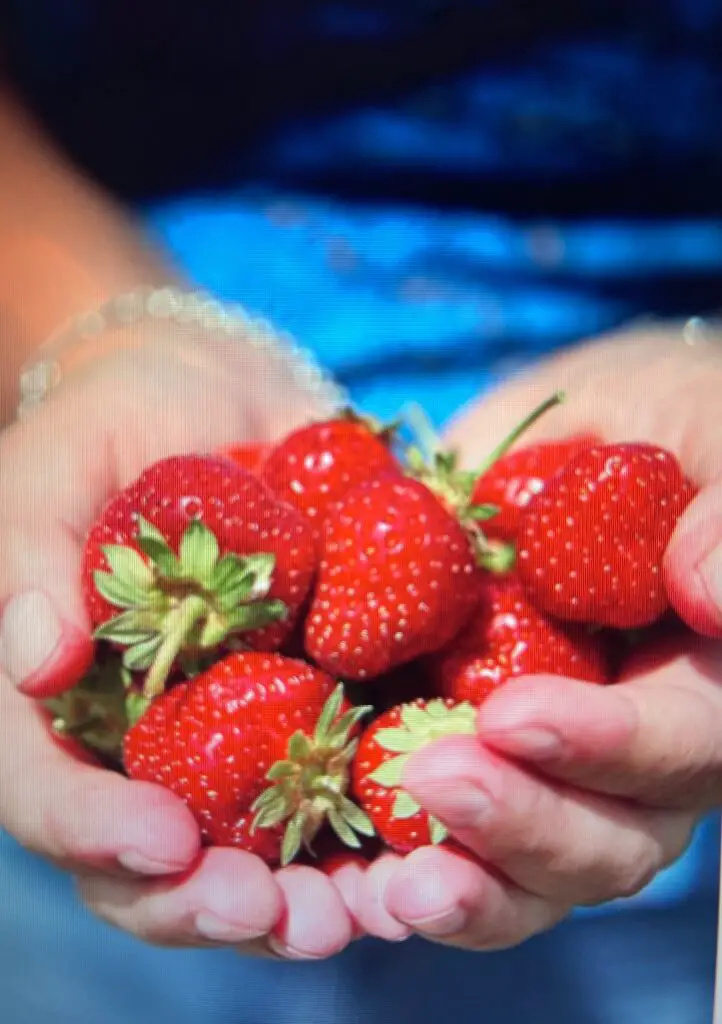The darlings of the berry world, homegrown strawberries are delicious just off the vine! But if you lack garden space, struggle with garden pests, or have excessive shade, harvesting your homegrown strawberries might seem like a pipe dream.
Not so! Growing strawberries in containers is an excellent option for those of you who have trouble growing nature’s candy in your gardens. And strawberries spilling out of gorgeous planters in the back yard of your home is absolutely quintessential farmhouse style.
Contents
What Types of Strawberries Grow Best in Containers?
There are two kinds of strawberries: June-bearing and everbearing.
June-bearing
The more popular of the two, June-bearing strawberries, produce large yields in the early summer (usually in June). They also make a lot of “daughters” (also known as runners).
Everbearing
These smaller strawberries produce slightly lower yields than June-bearing; however, they proffer up 2–3 crops a year from late spring into early fall.
Of the two, everbearing strawberries are more suitable for containers because they engender fewer runners and can be grown as annuals like other garden vegetables.

What Type of Container Should You Use?
There are many different types of containers, from huge terracotta pots to window boxes and everything in between. Still, most people prefer the look of the classic clay terracotta strawberry pot. It’s a good choice with its multitude of side pockets and sturdy shape and size.
The classic strawberry pot is also ideal because of the way strawberries grow. Strawberries have short root systems that work well in the small side planter pockets. While it appears they may spill right out of those side holes, dirt and all, they don’t, but rather take root quite quickly.
If you don’t have this classic pot, never fear! There are other terrific options.
Plastic pots — while not as sustainable as clay or stoneware, plastic pots allow the soil to retain moisture and are lighter and easier to move around.
Hanging baskets work great, too, and look beautiful with strawberries pouring over the sides.
Fabric bag — big fabric planting bags are ideal for strawberries. You can find these in most hardware stores in the early spring.

Soil Requirements
The most important thing you can do for your strawberries is start them off in the right soil. A good 50/50 blend of potting soil and organic compost is your best bet. You’ll also want to mix in some slow-release fertilizer that has a 10–10–10 mix of Nitrogen-Phosphorous-Potassium (also known as NPK). Follow the instructions, as you don’t want to overfertilize and burn your new baby plants.
Planting the Strawberries
Now comes the fun part!
The best time to plant container strawberries is in the early spring. Make sure to place your containers in an area that gets about 8–12 hours of sunlight per day. If this isn’t possible, plant your strawberries in containers that are easy to move around (or put the larger, heavier containers on a rolling dolly) and track the sun throughout the day.
Strawberries are difficult to grow from seed, so it’s better to go to the nursery early spring and purchase tiny bare-root everbearing strawberry rootballs. They come in bags of about ten, and you can find them near the seed potatoes in most nurseries. These are dormant plants that look pretty sad with just a few spindly leaves; however, they perk up dramatically once settled into the soil.
You can plant strawberries pretty close together. Eight inches apart is the recommendation, but you’ll get even more juicy strawberries if you pack them in at about six inches without any detriment to the plant. Each of those tiny plants will produce a whopping 1 lb of fruit by the end of the harvest season!

Care and Feeding
Water your strawberries twice a week in the summer; if days are extra hot and dry, up it to three times a week. Soil moisture meters are also helpful in container gardening, allowing you to set up a more precise watering schedule for your climate/microclimate.
Feed your strawberries a balanced fertilizer about every two weeks. Sprinkle a small amount over the top of the soil (avoid getting it on the leaves — this can burn your plant) and then water thoroughly. Fertilizer meant for tomatoes works well for strawberries too! If you notice the plants are leafy but not bearing as much fruit as you’d like, hold back on the fertilizer for a couple of weeks.
Harvest Time!
Everbearing strawberries produce 2–3 times per growing season. If you notice birds are getting at your plants, make sure to drape some bird netting over them to keep those pesky birds away! (They can enjoy wild berries in the forest!)
Remember, for the most flavorful berries, harvest timing is important. Pick your berries when they’re bright red all over. Once they turn dark red, they become dry and mushy. Check your containers every few days during harvest season, as you’ll be shocked at how quickly strawberries go from pinkish to perfect picking red.


